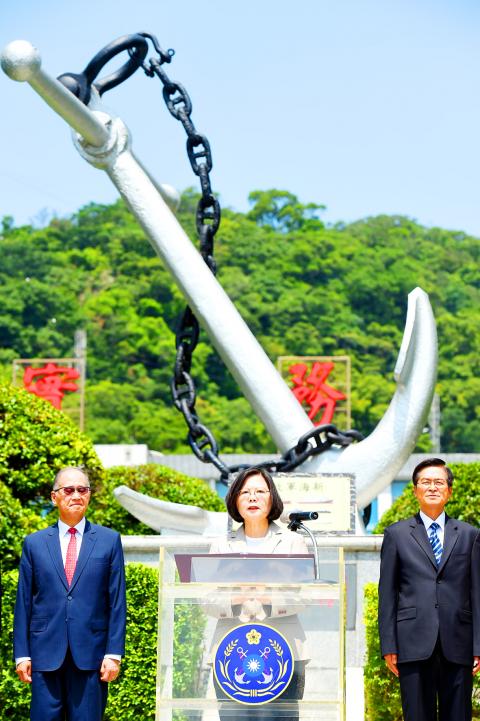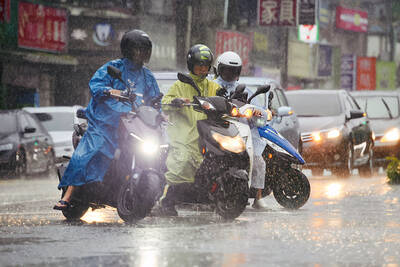Taiwan will spend more than one-fifth of its defense budget next year on the development of indigenous weapons, in line with the government’s policy of strengthening national security, President Tsai Ing-wen (蔡英文) said yesterday.
In the government’s proposals for next year’s national budget, defense spending is to increase by NT$18.3 billion (US$597.5 million) from the previous year to NT$346 billion, which represents 2.16 percent of the nation’s GDP, Tsai said.
Of the total defense budget, NT$73.6 billion, or 21.3 percent, is to be spent on developing indigenous defense systems, an increase of NT$25 billion, as part of the effort to broaden the nation’s warfare capability, she said.

Photo: Chu Pei-hsiung, Taipei Times
The proposals also include NT$95.1 billion for military investment, an increase of NT$13.9 billion from the previous year, Tsai said during the unveiling of a plaque at Navy Command Headquarters.
The plaque, which bears the inscription “New Navy Sets Sail,” symbolizes the beginning of a new era for the navy, during which it will use domestically built submarines, Tsai said, referring to the nation’s ongoing construction of defense submarines.
Since the late 1980s, when Taiwan bought two Dutch-built Zwaardvis-class diesel submarines, it has had difficulty procuring others and had been planning to build its own, Tsai said.
However, because of the challenges facing the nation, the idea got stuck until she came to office in 2016.
“Faced with such challenges, we should try to resolve them, instead of recoiling in fear,” she said.
The administration has been integrating resources from industry, academia, government and international partners to push its program forward, she said.
“Step by step, we have been making progress in resolving the bottlenecks in innovation and manufacturing,” Tsai said.
In related developments, a defense official on Sunday said that the construction costs for the first three mass-produced Tuo Jiang-class corvettes would be increased from NT$14.4 billion to NT$16.1 billion.
The navy plans to follow the class’ lead ship, the Tuo Jiang PG-618, with three anti-aircraft Flight I ships and five anti-ship and anti-submarine Flight II ships by 2025, in addition to Flight III ships whose specifications and production schedule are not yet known.
Due to adjustments to the hull design, the ships would have a projected displacement of 700 tonnes compared with the Tuo Jiang’s 567 tonnes.
Navy Command last week appointed the Chungshan Institute of Science and Technology to oversee the construction program of the three Flight I ships, which is to be implemented by select contractors, the official said on condition of anonymity.
Flight I Tuo Jiang-class corvette armaments are to consist of Tien Chien II (TC-2) surface-to-air missiles, while the Flight IIs would be a mix of Hsiung Feng II and Hsiung Feng III cruise missiles.
Additionally, the navy has made strides in the indigenous submarine program after the US Department of State in April authorized US firms to export submarine technology to Taiwan, the official said.
The granting of licenses enabled US firms to cut out intermediaries and deal with the Taiwanese government directly, the official said.
The administration has been briefed by six international corporations from the US, the EU, Japan and India in connection with their offers of technical assistance for the submarine program, the official said.
An Indian firm has invited navy officers and CSBC Corp, Taiwan (台灣國際造船) representatives to visit its facilities in-country, the official added.

The combined effect of the monsoon, the outer rim of Typhoon Fengshen and a low-pressure system is expected to bring significant rainfall this week to various parts of the nation, the Central Weather Administration (CWA) said. The heaviest rain is expected to occur today and tomorrow, with torrential rain expected in Keelung’s north coast, Yilan and the mountainous regions of Taipei and New Taipei City, the CWA said. Rivers could rise rapidly, and residents should stay away from riverbanks and avoid going to the mountains or engaging in water activities, it said. Scattered showers are expected today in central and

People can preregister to receive their NT$10,000 (US$325) cash distributed from the central government on Nov. 5 after President William Lai (賴清德) yesterday signed the Special Budget for Strengthening Economic, Social and National Security Resilience, the Executive Yuan told a news conference last night. The special budget, passed by the Legislative Yuan on Friday last week with a cash handout budget of NT$236 billion, was officially submitted to the Executive Yuan and the Presidential Office yesterday afternoon. People can register through the official Web site at https://10000.gov.tw to have the funds deposited into their bank accounts, withdraw the funds at automated teller

COOPERATION: Taiwan is aligning closely with US strategic objectives on various matters, including China’s rare earths restrictions, the Ministry of Foreign Affairs said Taiwan could deal with China’s tightened export controls on rare earth metals by turning to “urban mining,” a researcher said yesterday. Rare earth metals, which are used in semiconductors and other electronic components, could be recovered from industrial or electronic waste to reduce reliance on imports, National Cheng Kung University Department of Resources Engineering professor Lee Cheng-han (李政翰) said. Despite their name, rare earth elements are not actually rare — their abundance in the Earth’s crust is relatively high, but they are dispersed, making extraction and refining energy-intensive and environmentally damaging, he said, adding that many countries have opted to

CONCESSION: A Shin Kong official said that the firm was ‘willing to contribute’ to the nation, as the move would enable Nvidia Crop to build its headquarters in Taiwan Shin Kong Life Insurance Co (新光人壽) yesterday said it would relinquish land-use rights, or known as surface rights, for two plots in Taipei’s Beitou District (北投), paving the way for Nvidia Corp to expand its office footprint in Taiwan. The insurer said it made the decision “in the interest of the nation’s greater good” and would not seek compensation from taxpayers for potential future losses, calling the move a gesture to resolve a months-long impasse among the insurer, the Taipei City Government and the US chip giant. “The decision was made on the condition that the Taipei City Government reimburses the related